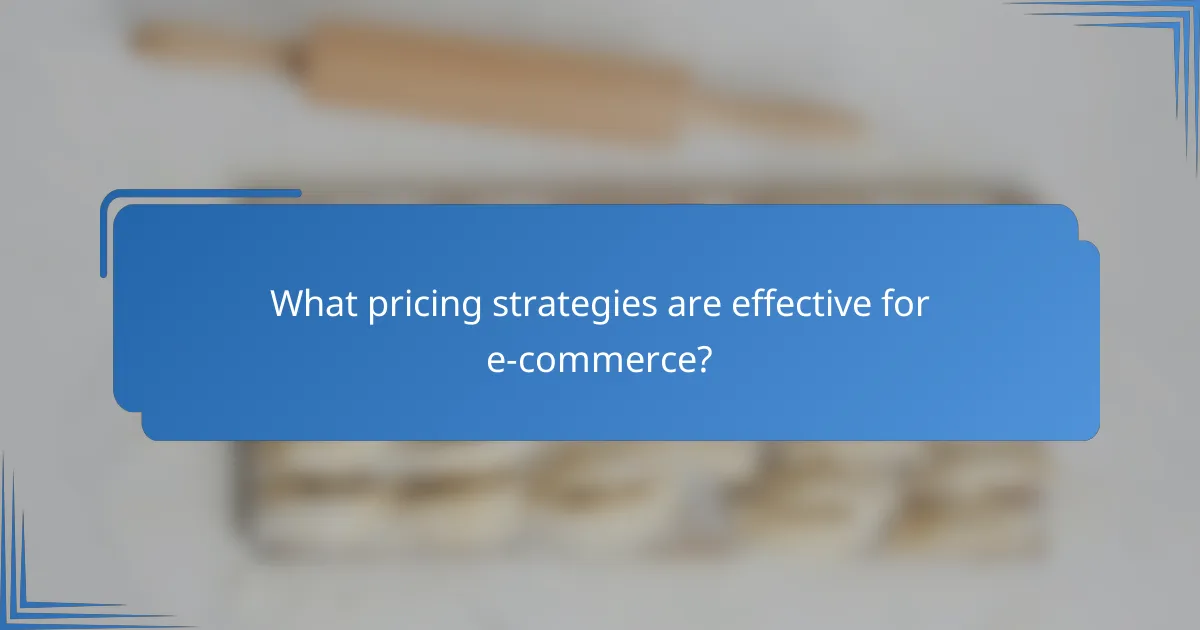Understanding current market pricing trends is essential for businesses aiming to navigate the complexities of consumer behavior and economic fluctuations. By conducting a competitive analysis, companies can uncover valuable insights into their competitors’ pricing strategies, enabling them to position their offerings effectively. Implementing innovative pricing strategies, such as dynamic and psychological pricing, can further enhance market positioning and drive sales growth.

What are the current market pricing trends in Australia?
Current market pricing trends in Australia indicate a growing focus on consumer price sensitivity, a shift towards value-based pricing, and the significant impact of inflation on pricing strategies. Businesses are adapting their pricing models to meet changing consumer expectations and economic conditions.
Increased price sensitivity among consumers
Consumers in Australia are becoming increasingly price-sensitive, influenced by economic pressures and rising living costs. This trend means that businesses must carefully consider their pricing strategies to remain competitive while still appealing to budget-conscious shoppers.
To address this sensitivity, companies can implement promotional strategies, such as discounts or loyalty programs, to attract and retain customers. Understanding the target audience’s willingness to pay is crucial for setting prices that balance profitability with customer satisfaction.
Shift towards value-based pricing
There is a notable shift towards value-based pricing in the Australian market, where businesses set prices based on the perceived value of their products or services rather than solely on costs. This approach allows companies to capture a larger share of consumer surplus and differentiate themselves from competitors.
To effectively implement value-based pricing, businesses should conduct market research to understand customer needs and preferences. Communicating the unique benefits of a product can justify higher prices and enhance customer loyalty.
Impact of inflation on pricing strategies
Inflation has a significant impact on pricing strategies in Australia, forcing companies to reassess their pricing models to maintain margins. Rising costs of raw materials and labor can lead to price increases, which must be managed carefully to avoid losing customers.
Businesses should consider gradual price adjustments rather than sudden hikes to minimize customer backlash. Regularly reviewing costs and market conditions can help companies make informed decisions about when and how to adjust their prices in response to inflationary pressures.

How to conduct a competitive pricing analysis?
Conducting a competitive pricing analysis involves evaluating the pricing strategies of your key competitors to understand market dynamics and position your offerings effectively. This process helps identify pricing trends, gaps, and opportunities that can inform your own pricing strategy.
Identify key competitors in the Australian market
To start, pinpoint the main competitors within your industry in Australia. Focus on businesses that offer similar products or services and target the same customer base. Consider both direct competitors and those that provide substitute products.
Utilize online resources, industry reports, and local business directories to compile a list of these competitors. Pay attention to their market share, customer reviews, and overall reputation to gauge their impact on your pricing strategy.
Analyze competitor pricing structures
Once you have identified your competitors, examine their pricing structures closely. Look at their pricing models—whether they use cost-plus pricing, value-based pricing, or competitive pricing—and how these models affect their market positioning.
Consider the range of prices offered by competitors for similar products. This can help you determine where your pricing should fall within the market spectrum, whether you aim to be a premium provider or a budget-friendly option.
Utilize tools like SEMrush for data
Leverage tools such as SEMrush to gather data on competitor pricing and market trends. These tools can provide insights into competitors’ pricing strategies, traffic sources, and customer engagement metrics, which are crucial for informed decision-making.
By analyzing this data, you can identify pricing patterns and adjust your strategy accordingly. Regularly monitoring these insights can help you stay competitive and responsive to market changes.

What pricing strategies are effective for e-commerce?
Effective pricing strategies for e-commerce include dynamic pricing, psychological pricing, and bundle pricing. These approaches help businesses optimize their pricing to attract customers, increase sales, and enhance market positioning.
Dynamic pricing for real-time adjustments
Dynamic pricing allows e-commerce businesses to adjust prices in real-time based on market demand, competitor pricing, and inventory levels. This strategy can maximize revenue by responding quickly to changes in consumer behavior or external factors.
To implement dynamic pricing, consider using software that analyzes data and adjusts prices automatically. Monitor competitors’ prices regularly and set rules for price changes to avoid customer dissatisfaction. For example, during peak shopping seasons, prices may increase, while discounts can be offered during slower periods.
Psychological pricing techniques
Psychological pricing leverages consumer psychology to influence purchasing decisions. Common techniques include pricing items just below a round number, such as $19.99 instead of $20, which can make products seem more affordable.
Another effective method is the use of charm pricing, where prices ending in .99 or .95 are perceived as better deals. Additionally, presenting higher-priced items alongside lower-priced alternatives can make the latter appear more attractive. Test various pricing formats to find what resonates best with your target audience.
Bundle pricing for increased sales
Bundle pricing involves offering multiple products together at a reduced price, encouraging customers to purchase more items. This strategy can increase average order value and enhance customer satisfaction by providing perceived savings.
When creating bundles, ensure the products complement each other, such as a phone with a case and screen protector. Consider offering discounts that are appealing but still profitable, typically in the range of 10-30% off the total price if purchased separately. Monitor sales data to refine your bundling strategy over time.

How to position your brand in the market?
Positioning your brand in the market involves defining its unique identity and value to effectively reach your target audience. This process requires a clear understanding of your competitive landscape and customer preferences.
Define your unique selling proposition
Your unique selling proposition (USP) is what sets your brand apart from competitors. It should clearly articulate the specific benefits or features that make your product or service distinct. For example, if you offer eco-friendly products, emphasize sustainability as a core aspect of your brand.
To identify your USP, analyze competitors and pinpoint gaps in their offerings. Consider what your customers value most and how you can address those needs better than others in the market.
Utilize customer feedback for positioning
Customer feedback is crucial for effective brand positioning. Regularly collect insights through surveys, reviews, and social media interactions to understand how your audience perceives your brand. This information can guide adjustments to your positioning strategy.
For instance, if customers highlight exceptional customer service as a key reason for their loyalty, you can leverage this strength in your marketing materials. Aim to create a feedback loop where customer input continuously informs your brand’s positioning.
Leverage social media for brand awareness
Social media platforms are powerful tools for enhancing brand awareness and positioning. Use channels like Instagram, Facebook, and LinkedIn to share content that reflects your brand’s values and engages your target audience. Consistent messaging across these platforms reinforces your brand identity.
Consider running targeted ad campaigns to reach specific demographics, and utilize analytics to track engagement and adjust your strategies accordingly. Engaging with your audience through comments and direct messages can also strengthen brand loyalty and awareness.

What factors influence pricing decisions?
Pricing decisions are influenced by a variety of factors, including costs, market demand, and regulatory frameworks. Understanding these elements helps businesses set competitive prices that align with their strategic goals.
Cost of goods sold and overhead
The cost of goods sold (COGS) and overhead expenses are fundamental to pricing strategies. COGS includes direct costs associated with producing goods, while overhead encompasses indirect costs like rent and utilities. Businesses typically aim to set prices that cover these costs and provide a profit margin.
For example, if the COGS for a product is $50 and overhead costs are $20, a company may set a price of at least $80 to ensure profitability. Regularly reviewing these costs is essential to adapt pricing as expenses fluctuate.
Market demand and consumer behavior
Market demand and consumer behavior significantly impact pricing decisions. High demand for a product can allow businesses to charge premium prices, while low demand may necessitate discounts to stimulate sales. Understanding consumer preferences and purchasing patterns is crucial for effective pricing.
For instance, during peak seasons, such as holidays, businesses may increase prices due to heightened demand. Conversely, during off-peak times, they might offer promotions or lower prices to attract customers. Conducting market research can provide insights into these trends.
Regulatory considerations in Australia
In Australia, businesses must navigate various regulatory considerations that affect pricing. The Australian Competition and Consumer Commission (ACCC) enforces laws against misleading pricing practices and price fixing. Compliance with these regulations is vital to avoid penalties.
Additionally, businesses should be aware of the Goods and Services Tax (GST) which affects pricing structures. For example, if a product is priced at AUD 100, it must include GST, impacting the final price consumers pay. Staying informed about local regulations ensures that pricing strategies remain compliant and competitive.
